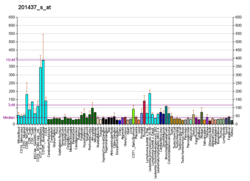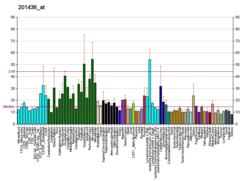eIF4E


eIF4E(eukaryotic translation initiation factor 4E)は、ヒトではEIF4E遺伝子にコードされるタンパク質である。
構造と機能
[編集]真核生物細胞のほとんどのmRNAは、5'末端が7-メチル-グアノシンの5'キャップ構造(m7GpppX、Xは任意のヌクレオチド)によって保護されている。この構造は、翻訳、スプライシング、mRNAの安定性、RNAの核外搬出の向上など、いくつかの細胞過程と関係している。eIF4EはmRNAのキャップ構造をリボソームへ差し向ける真核生物の翻訳開始因子である。24 kDaのポリペプチドで、遊離型またはeIF4F複合体の一部として存在する[5]。ほぼすべてのmRNAは、タンパク質へ翻訳されるためにeIF4Eを必要とする。eIF4Eは真核生物の翻訳装置の律速となる構成要素であり、真核生物におけるタンパク質合成においてmRNAとリボソームの結合段階に関与している。
eIF4Fの他のサブユニットは、ATPアーゼ活性とRNAヘリカーゼ活性を持つ47 kDaのeIF4Aと[6]、足場タンパク質である220 kDaのeIF4Gである[7][8]。
一部のウイルスは、eIF4GのeIF4E結合部位が除去されるようにeIF4Gを切断する。ウイルスはeIF4Eがなくともタンパク質への翻訳を行うことができる。また、一部の細胞タンパク質も翻訳にeIF4Eを必要とせず、そのようなタンパク質として最もよく知られているものは熱ショックタンパク質である。ウイルスタンパク質もこうした細胞タンパク質のどちらも、RNA中のIRESを介してタンパク質への翻訳が行われる。
調節
[編集]eIF4Eは比較的存在量の少ない翻訳開始因子であるため、翻訳制御の標的となっている[9]。eIF4Eの調節は、転写、リン酸化、阻害タンパク質という3つの異なる機構によって行われている可能性がある。
遺伝子発現による調節
[編集]eIF4Eの転写調節を担う機構は完全には理解されていない。しかしながら、いくつかの報告からはmycのレベルとeIF4EのmRNAのレベルが細胞周期を通して相関していることが示唆されている[10]。この関係は、eIF4Eの遺伝子のプロモーター領域に2つのmyc結合部位(CACGTG E-boxリピート)が特定されたことによって、さらなる裏付けが得られている[11]。この配列モチーフはmycのin vivoでの他の2つの標的と共通しており、eIF4EのE-boxリピートの変異はプロモーター領域を不活性化して発現を低下させる。
リン酸化による調節
[編集]細胞増殖を促進するホルモン、成長因子、分裂促進因子などの刺激は、eIF4Eをリン酸化することで翻訳率も向上させる[12]。eIF4Eのリン酸化と翻訳率は常に相関しているわけではないが、細胞周期を通して、リン酸化レベルはG0期とM期に低く、G1期とS期に高い、という一貫したパターンが観察される[13]。このことは、eIF4Eのセリン209番残基のリン酸化がeIF4Eのキャップ化mRNAに対する親和性を向上させることを示唆する結晶構造によっても支持されている。
阻害タンパク質による調節
[編集]eIF4F複合体の組み立ては4E-BP(eIF4E-binding protein)と呼ばれるタンパク質によって阻害される。4E-BPは小さな熱安定タンパク質で、キャップ依存的翻訳を阻害する[14]。非リン酸化4E-BPはeIF4Eと強固に相互作用することで翻訳を防ぐ。一方、リン酸化された4E-BPはeIF4Eに弱くしか結合しないため、翻訳過程に干渉することはない[15]。さらに、4E-BPの結合はeIF4EのSer209のリン酸化を阻害する[16]。
がんにおける役割
[編集]eIF4Eの過剰発現が線維芽細胞の腫瘍化を引き起こすことが発見されたことで、がんにおけるeIF4Eの役割は確立された[17]。この発見以降、さまざまな細胞株で同様の結果が得られている[18]。その結果、eIF4Eの活性は乳がん、肺がん、前立腺がんを含むいくつかのがんへ関与していることが示唆されている。ヒトの転移性腫瘍の転写プロファイリングからは、eIF4Eが常にアップレギュレーションされている場合には代謝に明確なサインがみられることが明らかにされている[19]。
FMRPのeIF4Eへの結合による翻訳抑制
[編集]FMRP(FMR1)は、eIF4Eへの結合によって特定のmRNAの翻訳を調節する。FMRPはCYFIP1に結合することで作用し、CYFIP1は4E-BP(4E-BP1、4E-BP2、4E-BP3)に構造的に類似したドメインを介してeIF4Eに直接結合する。FMRP/CYFIP1複合体は、翻訳に必要なeIF4E/eIF4G間の相互作用を妨げるように結合する。FMRP/CYFIP1/eIF4E間の相互作用は、RNAの存在によって強化される。特に、BC1 RNAはFMRPとCYFIP1の間の最適な相互作用を可能にする[20]。BC1 RNAは樹状突起に存在する翻訳されないRNAで、FMRPに結合して特定の標的mRNAとの結合を可能にする。BC1はFMRPを適したmRNAへリクルートすることで、シナプスでのFMRPとmRNAの間の相互作用を調節している可能性がある[21]。
さらに、FMRPは翻訳を抑制するために特定のmRNAへCTFIP1をリクルートする。FMRP-CYFIP1翻訳阻害因子は神経細胞の刺激によって調節される。シナプスの刺激の増加はCYFIP1のeIF4Eからの解離を引き起こし、翻訳開始を可能にする[20]。
相互作用
[編集]EIF4Eは次に挙げる因子と相互作用することが示されている。
出典
[編集]- ^ a b c GRCh38: Ensembl release 89: ENSG00000151247 - Ensembl, May 2017
- ^ a b c GRCm38: Ensembl release 89: ENSMUSG00000028156 - Ensembl, May 2017
- ^ Human PubMed Reference:
- ^ Mouse PubMed Reference:
- ^ “Eukaryotic mRNA cap binding protein: purification by affinity chromatography on sepharose-coupled m7GDP.”. Proceedings of the National Academy of Sciences of the United States of America 76 (9): 4345–9. (September 1979). doi:10.1073/pnas.76.9.4345. PMC 411571. PMID 291969.
- ^ “In vivo interaction between CDKA and eIF4A: a possible mechanism linking translation and cell proliferation”. FEBS Lett. 556 (1–3): 91–4. (2004). doi:10.1016/S0014-5793(03)01382-6. PMID 14706832.
- ^ “Targeting Eukaryotic Translation Initiation Factor 4E (eIF4E) in Cancer”. Clinical Cancer Research 16 (20): 4914–4920. (11 August 2010). doi:10.1158/1078-0432.CCR-10-0433. PMC 7539621. PMID 20702611.
- ^ “Amino acid sequence of the mRNA cap-binding protein from human tissues”. Proceedings of the National Academy of Sciences of the United States of America 84 (4): 945–9. (February 1987). doi:10.1073/pnas.84.4.945. PMC 304336. PMID 3469651.
- ^ Duncan, R.; Milburn, S. C.; Hershey, J. W. (1987-01-05). “Regulated phosphorylation and low abundance of HeLa cell initiation factor eIF-4F suggest a role in translational control. Heat shock effects on eIF-4F”. The Journal of Biological Chemistry 262 (1): 380–388. ISSN 0021-9258. PMID 3793730.
- ^ Rosenwald, I. B.; Rhoads, D. B.; Callanan, L. D.; Isselbacher, K. J.; Schmidt, E. V. (1993-07-01). “Increased expression of eukaryotic translation initiation factors eIF-4E and eIF-2 alpha in response to growth induction by c-myc”. Proceedings of the National Academy of Sciences of the United States of America 90 (13): 6175–6178. doi:10.1073/pnas.90.13.6175. ISSN 0027-8424. PMC 46890. PMID 8327497.
- ^ Jones, R. M.; Branda, J.; Johnston, K. A.; Polymenis, M.; Gadd, M.; Rustgi, A.; Callanan, L.; Schmidt, E. V. (September 1996). “An essential E box in the promoter of the gene encoding the mRNA cap-binding protein (eukaryotic initiation factor 4E) is a target for activation by c-myc”. Molecular and Cellular Biology 16 (9): 4754–4764. doi:10.1128/mcb.16.9.4754. ISSN 0270-7306. PMC 231476. PMID 8756633.
- ^ Morley, S. J.; Traugh, J. A. (1990-06-25). “Differential stimulation of phosphorylation of initiation factors eIF-4F, eIF-4B, eIF-3, and ribosomal protein S6 by insulin and phorbol esters”. The Journal of Biological Chemistry 265 (18): 10611–10616. ISSN 0021-9258. PMID 2191953.
- ^ Bonneau, A. M.; Sonenberg, N. (1987-08-15). “Involvement of the 24-kDa cap-binding protein in regulation of protein synthesis in mitosis”. The Journal of Biological Chemistry 262 (23): 11134–11139. ISSN 0021-9258. PMID 3038908.
- ^ Richter, Joel D.; Sonenberg, Nahum (2005-02-03). “Regulation of cap-dependent translation by eIF4E inhibitory proteins”. Nature 433 (7025): 477–480. doi:10.1038/nature03205. ISSN 1476-4687. PMID 15690031.
- ^ Peter, Daniel; Igreja, Cátia; Weber, Ramona; Wohlbold, Lara; Weiler, Catrin; Ebertsch, Linda; Weichenrieder, Oliver; Izaurralde, Elisa (2015-03-19). “Molecular architecture of 4E-BP translational inhibitors bound to eIF4E”. Molecular Cell 57 (6): 1074–1087. doi:10.1016/j.molcel.2015.01.017. ISSN 1097-4164. PMID 25702871.
- ^ Whalen, S. G.; Gingras, A. C.; Amankwa, L.; Mader, S.; Branton, P. E.; Aebersold, R.; Sonenberg, N. (1996-05-17). “Phosphorylation of eIF-4E on serine 209 by protein kinase C is inhibited by the translational repressors, 4E-binding proteins”. The Journal of Biological Chemistry 271 (20): 11831–11837. doi:10.1074/jbc.271.20.11831. ISSN 0021-9258. PMID 8662663.
- ^ Lazaris-Karatzas, A.; Montine, K. S.; Sonenberg, N. (1990-06-07). “Malignant transformation by a eukaryotic initiation factor subunit that binds to mRNA 5' cap”. Nature 345 (6275): 544–547. doi:10.1038/345544a0. ISSN 0028-0836. PMID 2348862.
- ^ Pelletier, Jerry; Graff, Jeremy; Ruggero, Davide; Sonenberg, Nahum (2015-01-15). “TARGETING THE eIF4F TRANSLATION INITIATION COMPLEX: A CRITICAL NEXUS FOR CANCER DEVELOPMENT”. Cancer Research 75 (2): 250–263. doi:10.1158/0008-5472.CAN-14-2789. ISSN 0008-5472. PMC 4299928. PMID 25593033.
- ^ Ramaswamy, Sridhar; Ross, Ken N.; Lander, Eric S.; Golub, Todd R. (January 2003). “A molecular signature of metastasis in primary solid tumors” (英語). Nature Genetics 33 (1): 49–54. doi:10.1038/ng1060. ISSN 1546-1718. PMID 12469122.
- ^ a b “The Fragile X Syndrome Protein Represses Activity-Dependent Translation through CYFIP1, a New 4E-BP”. Cell 134 (6): 1042–1054. (September 2008). doi:10.1016/j.cell.2008.07.031. PMID 18805096.
- ^ “The fragile X syndrome protein FMRP associates with BC1 RNA and regulates the translation of specific mRNAs at synapses”. Cell 112 (3): 317–27. (February 2003). doi:10.1016/S0092-8674(03)00079-5. PMID 12581522.
- ^ a b “Large-scale mapping of human protein-protein interactions by mass spectrometry”. Mol. Syst. Biol. 3: 89. (2007). doi:10.1038/msb4100134. PMC 1847948. PMID 17353931.
- ^ a b c “Hypoxia inhibits protein synthesis through a 4E-BP1 and elongation factor 2 kinase pathway controlled by mTOR and uncoupled in breast cancer cells”. Mol. Cell. Biol. 26 (10): 3955–65. (May 2006). doi:10.1128/MCB.26.10.3955-3965.2006. PMC 1489005. PMID 16648488.
- ^ “Towards a proteome-scale map of the human protein-protein interaction network”. Nature 437 (7062): 1173–8. (October 2005). doi:10.1038/nature04209. PMID 16189514.
- ^ a b c “The translation initiation factor eIF-4E binds to a common motif shared by the translation factor eIF-4 gamma and the translational repressors 4E-binding proteins”. Mol. Cell. Biol. 15 (9): 4990–7. (September 1995). doi:10.1128/MCB.15.9.4990. PMC 230746. PMID 7651417.
- ^ “Disruption of parallel and converging signaling pathways contributes to the synergistic antitumor effects of simultaneous mTOR and EGFR inhibition in GBM cells”. Neoplasia 7 (10): 921–9. (October 2005). doi:10.1593/neo.05361. PMC 1502028. PMID 16242075.
- ^ “Different roles for the TOS and RAIP motifs of the translational regulator protein 4E-BP1 in the association with raptor and phosphorylation by mTOR in the regulation of cell size”. Genes Cells 11 (7): 757–66. (July 2006). doi:10.1111/j.1365-2443.2006.00977.x. PMID 16824195.
- ^ “Mutational analysis of sites in the translational regulator, PHAS-I, that are selectively phosphorylated by mTOR”. FEBS Lett. 453 (3): 387–90. (June 1999). doi:10.1016/s0014-5793(99)00762-0. PMID 10405182.
- ^ “Cellular stresses profoundly inhibit protein synthesis and modulate the states of phosphorylation of multiple translation factors”. Eur. J. Biochem. 269 (12): 3076–85. (June 2002). doi:10.1046/j.1432-1033.2002.02992.x. PMID 12071973.
- ^ a b “Regulation of the rapamycin and FKBP-target 1/mammalian target of rapamycin and cap-dependent initiation of translation by the c-Abl protein-tyrosine kinase”. J. Biol. Chem. 275 (15): 10779–87. (April 2000). doi:10.1074/jbc.275.15.10779. PMID 10753870.
- ^ “Functional interaction between RAFT1/FRAP/mTOR and protein kinase cdelta in the regulation of cap-dependent initiation of translation”. EMBO J. 19 (5): 1087–97. (March 2000). doi:10.1093/emboj/19.5.1087. PMC 305647. PMID 10698949.
- ^ “Regulation of 4E-BP1 phosphorylation: a novel two-step mechanism”. Genes Dev. 13 (11): 1422–37. (June 1999). doi:10.1101/gad.13.11.1422. PMC 316780. PMID 10364159.
- ^ “Structural and thermodynamic behavior of eukaryotic initiation factor 4E in supramolecular formation with 4E-binding protein 1 and mRNA cap analogue, studied by spectroscopic methods”. Chem. Pharm. Bull. 49 (10): 1299–303. (October 2001). doi:10.1248/cpb.49.1299. PMID 11605658.
- ^ “Fed-state clamp stimulates cellular mechanisms of muscle protein anabolism and modulates glucose disposal in normal men”. Am. J. Physiol. Endocrinol. Metab. 296 (1): E105–13. (January 2009). doi:10.1152/ajpendo.90752.2008. PMC 2636991. PMID 18957614.
- ^ “Insulin-dependent stimulation of protein synthesis by phosphorylation of a regulator of 5'-cap function”. Nature 371 (6500): 762–7. (October 1994). doi:10.1038/371762a0. PMID 7935836.
- ^ “Localisation and regulation of the eIF4E-binding protein 4E-BP3”. FEBS Lett. 532 (3): 319–23. (December 2002). doi:10.1016/s0014-5793(02)03694-3. PMID 12482586.
- ^ “4E-BP3, a new member of the eukaryotic initiation factor 4E-binding protein family”. J. Biol. Chem. 273 (22): 14002–7. (May 1998). doi:10.1074/jbc.273.22.14002. PMID 9593750.
- ^ “A novel shuttling protein, 4E-T, mediates the nuclear import of the mRNA 5' cap-binding protein, eIF4E”. EMBO J. 19 (12): 3142–56. (June 2000). doi:10.1093/emboj/19.12.3142. PMC 203362. PMID 10856257.
- ^ “Amino acid-induced stimulation of translation initiation in rat skeletal muscle”. Am. J. Physiol. 277 (6 Pt 1): E1077–86. (December 1999). doi:10.1152/ajpendo.1999.277.6.E1077. PMID 10600798.
- ^ “mTOR-dependent stimulation of the association of eIF4G and eIF3 by insulin”. EMBO J. 25 (8): 1659–68. (April 2006). doi:10.1038/sj.emboj.7601047. PMC 1440840. PMID 16541103.
- ^ “A novel functional human eukaryotic translation initiation factor 4G”. Mol. Cell. Biol. 18 (1): 334–42. (January 1998). doi:10.1128/mcb.18.1.334. PMC 121501. PMID 9418880.
関連文献
[編集]- “Prevention of head and neck cancer: current status and future prospects”. Current Problems in Cancer 28 (5): 265–86. (2004). doi:10.1016/j.currproblcancer.2004.05.003. PMID 15375804.
- “Controlling gene expression through RNA regulons: the role of the eukaryotic translation initiation factor eIF4E”. Cell Cycle 6 (1): 65–9. (2007). doi:10.4161/cc.6.1.3688. PMID 17245113.
- “Translation initiation: variations in the mechanism can be anticipated”. Cellular and Molecular Life Sciences 68 (6): 991–1003. (2010). doi:10.1007/s00018-010-0588-z. PMID 21076851.
関連項目
[編集]外部リンク
[編集]- Cap-dependent translation initiation from Nature Reviews Microbiology.








